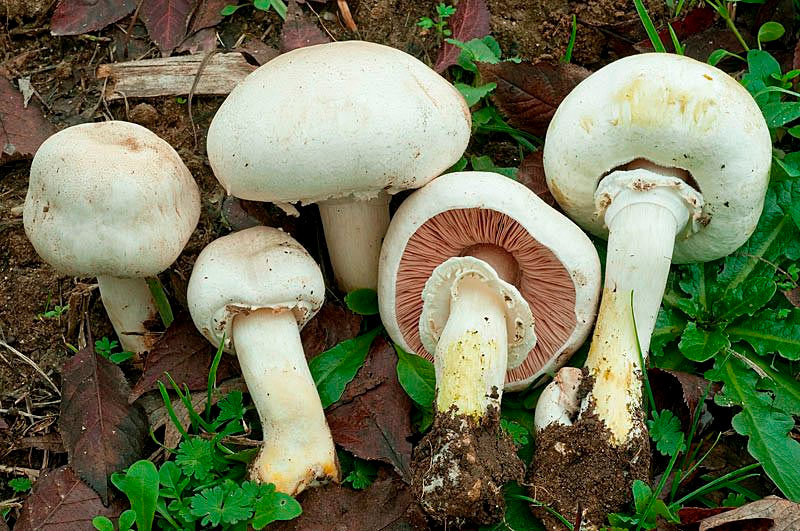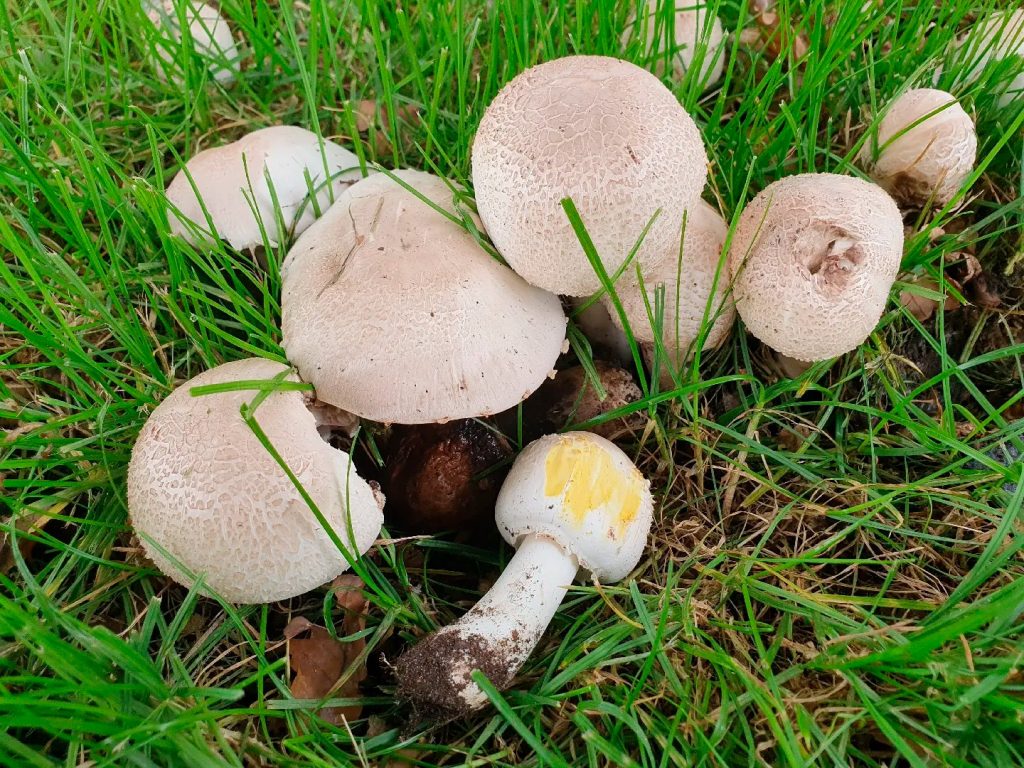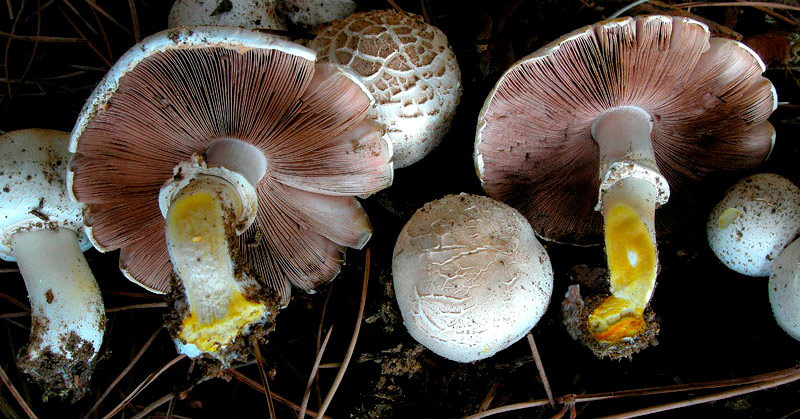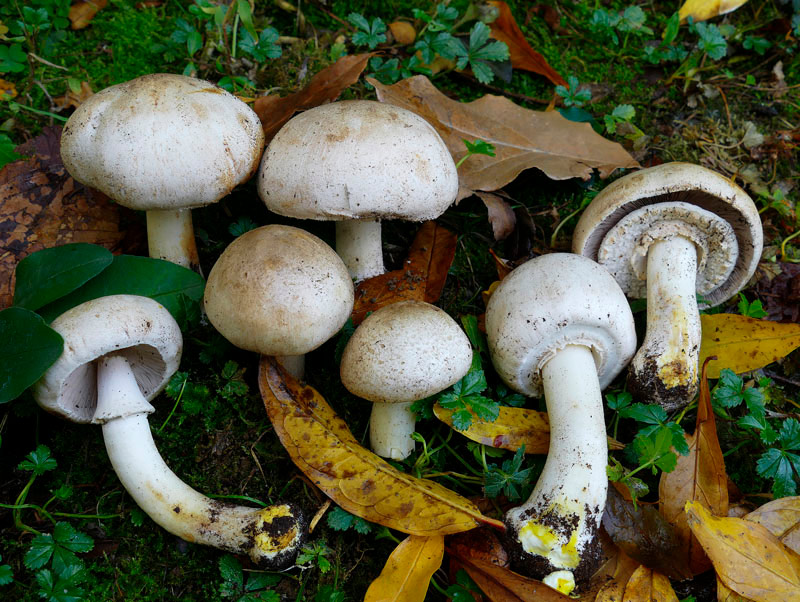Wild mushroom: Agaricus xanthodermus
3 years ago · Updated 6 months ago

Yellowing fungus can ruin your day
This mushroom has long been the subject of confusion. It's Agaricus xanthodermus, a poisonous species often confused with others in the same group that are edible. But don't worry, we'll help you distinguish between them and avoid any risk.
Want to know more about edible and poisonous mushrooms? We recommend this guide
Let's dive into the characteristics, habitat and possible confusions of Agaricus xanthodermus in this article.
Main characteristics of the Yellowing Agaricus
Cap and blades
The cap of this mushroom has a globular shape when young, with an outline reminiscent of a trapezoid. As it grows and matures, its shape changes from convex to spreading. A distinctive feature that sets it apart from other species in the Agaricus group is that, when touched, it takes on a yellow hue. This yellowing when rubbed is very common in this species and can help us to identify it.

The brim of the cap may be convoluted or curved when cut, becoming decurved as it matures. If we observe it from the perimeter, we'll notice that it has a full rim and often retains remnants of the universal veil, which is another detail that can help us distinguish this species.
The blades of Agaricus xanthodermus are initially tight when young and have a whitish color with pinkish tones. As they mature, they acquire a characteristic pink color that is maintained for most of their life. In the advanced stage, they darken to a grayish-brown hue, with slightly lighter edges.

Foot and flesh
The foot of this mushroom is more slender and separates easily from the cap. It has a cylindrical shape and is hollow inside. One way to distinguish it is that the foot tends to curve towards the base. Its size varies between 5 and 15 centimeters in height, with a diameter of around 1.5 centimeters. Initially, it is white in color, but when pressed or rubbed, it turns chrome yellow. This color change is most evident at the base of the foot.

A distinctive feature of this species is its wide ring, with a double rim and differentiated faces. The upper face of the ring has a more membranous, consistent appearance, while the inner face is more fugaceous and toothed, and tends to adhere to the foot.
The flesh of Agaricus xanthodermus is compact and consistent when young, and white in color. However, when pressed or cut, it takes on a chrome-yellow hue, particularly at the base of the stalk. Over time, it turns brown and then gray. It also has an unpleasant taste and a characteristic phenolic odor that intensifies with cooking. This odor can be another useful indicator for distinguishing this mushroom.
Habitat of Agaricus xanthodermus
This species of mushroom usually appears in abundance along paths in various locations. It forms large, tightly-knit groups, so it's rare to find it in isolation. It thrives best in urban environments and can easily be found in cities, parks and gardens. It can also be found near dumps, manures and rubbish dumps.

Toxicity and confusions of A. xanthodermus with other fungi
Considered one of the most dangerous toxic agarics, the Agaricus xanthodermus, is a poisonous wild mushroom, although its toxicity is not very intense. Its consumption should be avoided because of its unpleasant taste and possible effect on digestion. Even a single specimen of Agaricus xanthodermus in a mushroom dish can spoil it both in quality and edibility.
One of the main confusions that can occur is with white amanites of the same habitat, such as Amanita verna, Amanita virosa and Amanita phalloides. These mushrooms are highly toxic and even lethal. The key difference to distinguish them is that white amanites have white lamellae and possess a volva, and never turn yellow when rubbed, pressed or cut.

It can also be confused with other edible white Agaricus, such as Agaricus sylvicola and Agaricus arvensis. These turn yellow when rubbed, and are generally the most confusing.
It's crucial to note that the Agaricus group can contain poisonous species, so it's best not to pick them if we're not sure of their identification. Fortunately, today, thanks to the Agaricus xanthoderma's association with urban environments, it's less likely to be confused with other species. Most people don't harvest fruits or mushrooms that grow in urban areas.
Yellowing mushroom poisoning symptoms, what to do
.
Although some people consume these yellowing mushrooms without suffering symptoms of intoxication, their consumption is not recommended, as they can cause gastrointestinal or resinoid-type poisoning. Symptoms usually appear within a short incubation period, usually less than 6 hours, and include nausea, vomiting, abdominal pain and diarrhea.
The severity of symptoms depends on the amount ingested, previous state of health and age. In general, they do not require hospitalization, and symptoms disappear within 1 or 2 days. However, in the case of children, the elderly and people with pre-existing pathologies, symptoms can be more severe, with possible tables of dehydration, muscle cramps and dizziness, which may require hospitalization to receive symptomatic treatment, such as serotherapy.

In the event of having consumed this species by mistake, it is advisable to go promptly to the nearest health center or call the Toxicological Information Service telephone: 915620420. These services are available 24 hours a day, every day of the year, and offer specialized advice.
In summary, Agaricus xanthodermus is a toxic mushroom that can be confused with other edible species. It's important to know its distinctive characteristics to avoid poisoning. Remember that it's best to refrain from picking mushrooms if you're not sure of their identification and, in the event of poisoning, seek medical advice immediately.
https://www.youtube.com/watch?v=GfQrs5BuuQ0
Now that you know what poisonous mushrooms look like, you can head out into the woods with your wicker basket and mushroom knife in peace.
Health and mushrooms!

Te pueden interesar